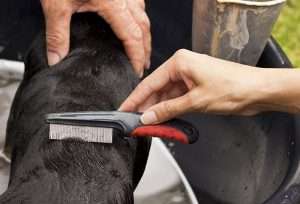Every dog owner knows the tiresome topic; ticks! From temperatures of plus 10 degrees Celsius, ticks can be active and cause a threat to your four-legged friends.
The bloodsuckers belong to the arachnids and are equipped with eight legs ready to latch on to your dog. Due to the fact these parasites react to moisture, they retreat with prolonged fair weather. However, once it rains again, they leave the protective shelter of the damp mulch to go in search of a ‘Victim’. This is according to Georg Duscher and his colleagues from the Institute of Parasitology; the Vienna Vetmed University bites which goes into detail about tick bites in dogs during different times of the year.
The ticks can transmit different pathogens, which can eventually lead to diseases. If your dog is attacked by ticks, it can be very annoying and uncomfortable for your pet and there are some health implications which should be considered.
Where do you find Parasites?
Whether you walk with your beloved four-legged along the riverbank, a city park, or through fields, everywhere lurking are annoying parasites. Most dogs are curious and full of energy when they go for a walk. They want to sniff out their surroundings and feel free. However, as soon as they stick their sensitive noses in the ground, it can lead to a tick infestation.
In case of large infestation, it could cause a serious problem for your dog. However, the greater danger comes from the pathogens that can be transmitted from these bloodsuckers to your best friend. Therefore, it is necessary that you take precautions as a dog owner. However, it is important to understand that you do not have to resort to using chemicals. Every dog owner should strive to keep chemical agents away from their animals as much as possible.
Where are Dogs usually Bitten by the Bloodsuckers?
Very often the bloodsuckers bite the animal on the point of impact. Therefore, dogs are usually attacked on the head. However, there have been cases where the dog has been attacked in front of the stomach, legs and back. It is important that you carefully scan the dog after each walk, as very often the ticks crawl through the fur without squeezing. Due to the ticks (it stings only the females, males do not need blood) taking a while to find a spot to bite on, it increases the chance of your dog bringing the parasite back into the home after walking.
When searching, a flea comb can help. The faster you free your four-legged friend from the parasites, the lower the risk of transmission of dangerous pathogens. It takes between 16-24 hours for most pathogens to pass to the animal. Among the tick family, the most famous ticks belongs the common wood buck This type of bloodsucker is known as a carrier of Lyme disease and meningoencephalitis (FSM).
The ‘Victim’ is tracked down by the Haller Organ
The ticks can stay hidden in the grass, gardens, forests, parks, bushes, everywhere! Particularly noteworthy is that they can last for several years without finding a host to feed them. If a “victim” is in their vicinity, it is tracked down by the Haller organ.
The Haller’s organ is a special olfactory organ. It reacts to compounds such as ammonia, carbon dioxide, but also to lactic acid, as well as to butyric acid. Once these substance levels are raised, it is an indication that your dog’s lifestyle if not as healthy as it should be. If you use a chemical leg for tick protection, the shot can backfire as you bring the immune system of the animal even more out of balance. Alternatively, an effective tick protection for the dog is a natural way of life
In addition to herbal remedies for ticks, a balanced way of life of the dog is a good condition that your animal is largely spared by the parasites. It’s also about keeping chemical toxins as far away from the four-legged friends as possible. Worming or vaccination should only be done if there is a need. Indulge your best friend with dog food that meets its nutritional needs very well. Moreover, the addition of brewer’s yeast can balance its acid-base balance and provide for a tick protection.
Tick Defence by Natural Means
There are numerous natural active ingredients to ward off the parasites from your dog. These are natural substances that can be applied to the fur of the animals. Other preparations, in turn, can be added to the feed of the animal in small quantities.
Coconut Oil for Tick Defence:
If you want to protect your four-legged friend against the parasites naturally, then you can resort to the use of coconut oil. The secret lies in the lauric acid content of these products.
For protection, coat your dog’s coat with some coconut oil. Pay special attention to the head of the animal, as well as to the ears. The natural remedy should be applied once a day. Some pet owners also swear by the administration of one teaspoon of coconut oil per day with the dogs feed.
TIP: Because coconut oil has no harmful side effects, it can also be used on small dogs and puppies.
Black Cumin Oil or Garlic for Tick Defence:
To prevent annoying tick infestation, depending on the size of the animal, between eight and ten drops of black cumin oil can be mixed into the dog feed. The use of these will have no side effects for your dog, but the dose should not be exceeded. You can also use essential oils, such as lavender, cloves, or eucalyptus.
The use of garlic to defend against ticks is controversial, however, the addition of half a clove of garlic in small animals and a toe for large dogs, two to three times a week is harmless.
Brewer’s yeast also has a tick-repelling effect thanks to the contained B vitamins.
TIP: Black cumin oil is not suitable for cats, they lack the necessary enzyme to break down essential oils.
If you do not like the above examples of natural tick defence solutions, you can also turn to a finished natural product. For example, the natural tick repellent Ani-Zeck from Anifit. The short spraying with the agent avoids or reduces the infestation of ticks.
Removal of Ticks with Special Tweezers or Tick Card
If your dog has been bitten by a tick, you should use a special tick tweezers or a tick card to tackle it. Never use oils, lacquers or glue. The faster you work and remove the tick, the greater the chance that no pathogens will be transmitted. The pathogens take up to 24 hours to enter the bloodstream of your dog and spread.
In no case should you squeeze the parasite. Use the tongs to pack heartily over the dog’s skin, slowly pulling out the bloodsucker. Afterwards you should disinfect the sore area of the dog with some alcohol. If the puncture site swells, or you cannot remove the tick, do not hesitate and seek help and assistance from a veterinarian.
Especially in dog breeds with a long coat, the search for the ticks can be complex. It may also be useful to learn shearing or seek advice to check for ticks in long haired dogs.
Lyme Disease in Dogs
Dogs are much less likely to develop Lyme disease than humans or cats. Around 95% of dogs have antibodies to protect against Borrelia. Dogs have similar genetic resistance to that of wild animals. This even goes so far that the immune system of dogs can often cope with infection. From this it is not always necessary to resort to chemical substances, which are mostly toxic.
You are welcome to tell us your experiences with various tick remedies in the comments.








